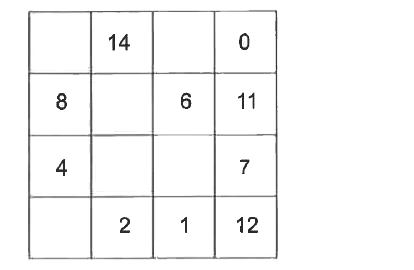In a magic square each row, column and diagonal have the same sum. Check which of the following is a magic square.
To determine if a square is a magic square, we need to check if the sums of each row, each column, and both diagonals are equal. Let's analyze the given square step by step.
Step 1: Identify the Square
Let's assume the square is represented as follows:
Row1:a1,a2,a3Row2:b1,b2,b3Row3:c1,c2,c3
Step 2: Calculate the Sums of Each Row
1. Row 1 Sum:
- Calculate the sum of the first row: \( a1 + a2 + a3 \)
2. Row 2 Sum:
- Calculate the sum of the second row: \( b1 + b2 + b3 \)
3. Row 3 Sum:
- Calculate the sum of the third row: \( c1 + c2 + c3 \)
Step 3: Check if Row Sums are Equal
- Compare the sums calculated in Step 2. If all three sums are equal, proceed to the next step. If not, it is not a magic square.
Step 4: Calculate the Sums of Each Column
1. Column 1 Sum:
- Calculate the sum of the first column: \( a1 + b1 + c1 \)
2. Column 2 Sum:
- Calculate the sum of the second column: \( a2 + b2 + c2 \)
3. Column 3 Sum:
- Calculate the sum of the third column: \( a3 + b3 + c3 \)
Step 5: Check if Column Sums are Equal
- Compare the sums calculated in Step 4. If all three sums are equal, proceed to the next step. If not, it is not a magic square.
Step 6: Calculate the Sums of the Diagonals
1. Main Diagonal Sum:
- Calculate the sum of the main diagonal: \( a1 + b2 + c3 \)
2. Secondary Diagonal Sum:
- Calculate the sum of the secondary diagonal: \( a3 + b2 + c1 \)
Step 7: Check if Diagonal Sums are Equal
- Compare the sums calculated in Step 6. If both diagonal sums are equal to the row and column sums, then it is a magic square. If not, it is not a magic square.
Conclusion
- If all rows, columns, and diagonals have the same sum, then the square is a magic square. If any of them differ, it is not a magic square.
Let's assume the square is represented as follows:
1. Row 1 Sum:
- Calculate the sum of the first row: \( a1 + a2 + a3 \)
2. Row 2 Sum:
- Calculate the sum of the second row: \( b1 + b2 + b3 \)
3. Row 3 Sum:
- Calculate the sum of the third row: \( c1 + c2 + c3 \)
- Compare the sums calculated in Step 2. If all three sums are equal, proceed to the next step. If not, it is not a magic square.
1. Column 1 Sum:
- Calculate the sum of the first column: \( a1 + b1 + c1 \)
2. Column 2 Sum:
- Calculate the sum of the second column: \( a2 + b2 + c2 \)
3. Column 3 Sum:
- Calculate the sum of the third column: \( a3 + b3 + c3 \)
- Compare the sums calculated in Step 4. If all three sums are equal, proceed to the next step. If not, it is not a magic square.
1. Main Diagonal Sum:
- Calculate the sum of the main diagonal: \( a1 + b2 + c3 \)
2. Secondary Diagonal Sum:
- Calculate the sum of the secondary diagonal: \( a3 + b2 + c1 \)
- Compare the sums calculated in Step 6. If both diagonal sums are equal to the row and column sums, then it is a magic square. If not, it is not a magic square.
- If all rows, columns, and diagonals have the same sum, then the square is a magic square. If any of them differ, it is not a magic square.
Topper's Solved these Questions
- INTEGERSBOOK - NCERTCHAPTER - INTEGERSEXERCISE - EXERCISE 1.4
7 Videos
- INTEGERSBOOK - NCERTCHAPTER - INTEGERSEXERCISE - EXERCISE 1.3
8 Videos
- INTEGERSBOOK - NCERTCHAPTER - INTEGERSEXERCISE - EXERCISE 1.3
8 Videos
- FRACTIONS AND DECIMALSBOOK - NCERTCHAPTER - FRACTIONS AND DECIMALSEXERCISE - EXERCISE 2.6
5 Videos
- LINES AND ANGLESBOOK - NCERTCHAPTER - LINES AND ANGLESEXERCISE - SOLVED EXAMPLES
1 Videos
Similar Questions
In a magic square each row, column and diagonal have the same sum , then the values of A and B are
View SolutionEXAMPLE 3 A magic square is an array of numbers having the same number of rows and columns and the sum of the numbers in a row column and the sum of the numbers in each row column or diagonal being the same. Fill in the blank cells of the following magic square.
View Solution
Knowledge Check
Which of the following nuclei are doubly magic?
A.92U238B.2He4C.8O16D.82Pb208Which of the following nuclie have two magic numbers ?
A.168OB.42HeC.23892UD.20882PbWhich of the following has magic number of neutrons?
A.13Al27B.83Bi209C.92U238D.26Fe56
A circle and a square have the same perimeter. Which one of the following is correct?
View SolutionA circle and a square have the same perimeter. Which one of the following is correct ?
View SolutionComplete the magic square

View SolutionWhich of the following nuclei is not double magic?
View SolutionWhich of the following numbers are called magic numbers?
View Solution
